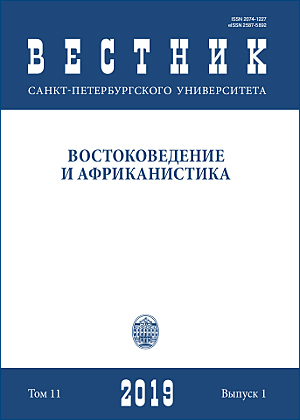Demographic Statistics among Pashtuns in Early Modern Period
DOI:
https://doi.org/10.21638/spbu13.2019.105Abstract
The article explores rare specimens of demographic statistics extracted from the seventeenth century works in Pashto and Persian which were composed in the Pashtun tribal territories. The study’s major source is the collection of historical accounts and genealogical records written by the Khaṫak tribal rulers Khushḥāl Khān (d. 1689) and his grandson Afżal Khān (d. circa 1740/41). These writings have survived in “The Khaṫaks’ Chronicle” — the archive of the Khaṫak chieftains included by Afżal Khān as a supplement into his historiographical compilation “The Ornamented History” (Tārīkh-i muraṣṣaʿ). Other sources are the poetical works of Khushḥāl Khān and the book in Persian by the theologian Akhūnd Darweza (d. 1618/19 or 1638/39) “An Account of Pious and Wicked” (Taẕkirat al-abrār wa-l-ashrār) which contains a report on the census conducted in the Yūsufzay tribe in the second quarter of the sixteenth century. The researched material includes data on the number of people in particular tribal units, birth dynamics, infant mortality and external negative factors, such as epidemics and natural disasters, that continuously affected demographic situation. The extant sources also shed light on family and matrimonial relations among Pashtuns in the sixteenth and seventeenth centuries. The facts examined in the article indicate that Pashtun tribal rulers were well familiar with the basics of practical demography which they needed to monitor the number of tribesmen while accomplishing specific administrative, military and economic tasks. The demographic notes left by the Khaṫak chieftains are to be considered among the most unique documents on the history and the culture of Pashtun tribes in early modern times.
Keywords:
Pashtun tribes, demographic statistics, historiography, tribal chronicles, genealogies, Pashto literature
Downloads
References
Downloads
Published
How to Cite
Issue
Section
License
Articles of "Vestnik of Saint Petersburg University. Asian and African Studies" are open access distributed under the terms of the License Agreement with Saint Petersburg State University, which permits to the authors unrestricted distribution and self-archiving free of charge.





